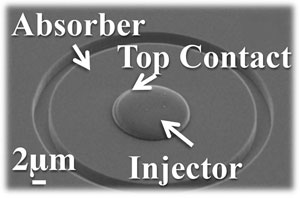

Photon detectors are now at the heart of many modern scientific, medical, industrial and security systems. These detectors, whether single-element or imaging arrays, are often the performance bottleneck in such systems. While cooled midwave- and longwave-infrared (MWIR and LWIR) detectors have reached the thermodynamic limit of sensitivity, achieving such performance has remained elusive at shorter wavelengths.
New research shows that devices based on electron injection might be able to approach the thermodynamic limit of sensitivity in shortwave-infrared (SWIR) detectors at relatively high temperatures. Because the energy of photons is significantly larger than the thermal energy in this region, non-cryogenic single-photon detectors with high detection efficiency and very low false detection rate seem feasible for the first time.
Presenter Dr. Hooman Mohseni is a professor of electrical engineering and computer sciences at Northwestern University. He is the recipient of several research and teaching award including the National Science Foundation’s CAREER Award, DARPA Young Faculty Award and Northwestern Faculty Honor Roll.
Mohseni serves on the editorial boards of IEEE Photonics, IEEE Selected Topics in Quantum Electronics, Optics Letter and Frontiers in Material. He has published more than 115 peer-reviewed articles in major journals including Nature, Nano Letters, and ACS Nano. He holds 14 issued U.S. and international patents. He is a fellow of SPIE and OSA.
|
MARK YOUR CALENDAR
Date: Thursday, Apr 9, 2015
Time: 1 PM EDT
|
Space is limited. Reserve your Webinar seat now at:
https://attendee.gotowebinar.com/register/3932714863789759234
After registering you will receive a confirmation email containing information about joining the Webinar.
|
SYSTEM REQUIREMENTS
PC-based attendees
Required: Windows® 8, 7, Vista, XP or 2003 Server
Mac®-based attendees
Required: Mac OS® X 10.6 or newer
Mobile attendees
Required: iPhone®, iPad®, Android™ phone or tablet, Windows 8 or Windows Phone 8
|
Visit Photonics Media to watch past webinars on demand to learn more about the latest developments in lasers, imaging, optics, biophotonics, machine vision, spectroscopy, microscopy, photovoltaics and more.
https://photonics.com/Webinars.aspx
|
|

|
|


|